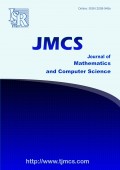Insight into degenerate Bell-based Bernoulli polynomials with applications
Authors
U. Duran
- Department of Basic Sciences of Engineering, Faculty of Engineering and Natural Sciences, Iskenderun Technical University, TR-31200 Hatay, Turkey.
S. Araci
- Department of Computer Engineering, Faculty of Engineering, Hasan Kalyoncu University, TR-27010 Gaziantep, Turkey.
M. Acikgoz
- Department of Mathematics, Faculty of Arts and Science, Gaziantep University, TR-27010 Gaziantep, Turkey.
Abstract
Recently, the Bell-based Stirling polynomials of the second kind and the
Bell-based Bernoulli polynomials [{U. Duran, S. Araci, M. Acikgoz, Axioms, \textbf{10} (2021), 23 pages}] have been considered, and some of their
properties and applications in umbral calculus have been derived and
analyzed. In this work, a degenerate form of the Bell-based Stirling
polynomials of the second kind is defined, and several fundamental
properties and formulas for these polynomials are investigated and presented
in detail. Then, a degenerate form of the Bell-based Bernoulli polynomials
of order \(\alpha \) is defined and a plenty of their properties\ are examined
in different aspects. Several correlations with other polynomials and
numbers in literature, symmetric identities, implicit summation formulas,
derivative properties and addition formulas for the mentioned new
polynomials are derived in detail, and some special cases of these results
are investigated. Also, the degenerate Bell-based Bernoulli polynomials of
order \(\varepsilon \) are studied in \(\lambda \)-umbral calculus and
interesting relations and formulas are developed. Furthermore, the
application of \(\lambda \)-umbral calculus to Bell-based degenerate Bernoulli
polynomials of order \(\varepsilon \) shows a correlation with higher-order
degenerate derangement polynomials. Finally, a representation of the
degenerate differential operator on the degenerate Bell-based Bernoulli
polynomials of order \(\varepsilon \) is provided.
Share and Cite
ISRP Style
U. Duran, S. Araci, M. Acikgoz, Insight into degenerate Bell-based Bernoulli polynomials with applications, Journal of Mathematics and Computer Science, 41 (2026), no. 2, 264--283
AMA Style
Duran U., Araci S., Acikgoz M., Insight into degenerate Bell-based Bernoulli polynomials with applications. J Math Comput SCI-JM. (2026); 41(2):264--283
Chicago/Turabian Style
Duran, U., Araci, S., Acikgoz, M.. "Insight into degenerate Bell-based Bernoulli polynomials with applications." Journal of Mathematics and Computer Science, 41, no. 2 (2026): 264--283
Keywords
- Bernoulli polynomials
- Bell polynomials
- mixed-type polynomials
- Stirling numbers of the second kind
- degenerate exponential function
- umbral calculus
MSC
References
-
[1]
E. T. Bell, Exponential polynomials, Ann. of Math. (2), 35 (1934), 258–277
-
[2]
L. Carlitz, Some remarks on the Bell numbers, Fibonacci Quart., 18 (1980), 66–73
-
[3]
L. Chen, T. Kim, D. S. Kim, H. Lee, S.-H. Lee, Probabilistic degenerate central Bell polynomials, Math. Comput. Model. Dyn. Syst., 30 (2024), 523–542
-
[4]
R. Dere, Y. Simsek, Applications of umbral algebra to some special polynomials, Adv. Stud. Contemp. Math. (Kyungshang), 22 (2012), 433–438
-
[5]
R. Dere, Y. Simsek, Hermite base Bernoulli type polynomials on the umbral algebra, Russ. J. Math. Phys., 22 (2015), 1–5
-
[6]
U. Duran, Central Bell-Based Type 2 Bernoulli Polynomials of Order β, Fundam. J. Math. Appl., 8 (2025), 55–64
-
[7]
U. Duran, S. Araci, M. Acikgoz, Bell-based Bernoulli polynomials with applications, Axioms, 10 (2021), 23 pages
-
[8]
N. Khan, S. Husain, Analysis of Bell based Euler polynomials and their application, Int. J. Appl. Comput. Math., 7 (2021), 16 pages
-
[9]
H. K. Kim, Some identities of the degenerate higher order derangement polynomials and numbers, Symmetry, 13 (2021), 16 pages
-
[10]
H. K. Kim, D. V. Dolgy, Degenerate Catalan-Daehee numbers and polynomials of order r arising from degenerate umbral calculus, AIMS Math., 7 (2022), 3845–3865
-
[11]
D. S. Kim, T. Kim, Degenerate Sheffer sequences and λ-Sheffer sequences, J. Math. Anal. Appl., 493 (2021), 21 pages
-
[12]
T. Kim, D. S. Kim, L.-C. Jang, H. Lee, H. Kim, Representations of degenerate Hermite polynomials, Adv. Appl. Math., 139 (2022), 18 pages
-
[13]
T. Kim, D. S. Kim, H. K. Kim, λ-q-Sheffer sequence and its applications, Demonstr. Math., 55 (2022), 843–865
-
[14]
T. Kim, D. S. Kim, H. Y. Kim, Some identities involving degenerate Stirling numbers arising from normal ordering, AIMS Math., 7 (2022), 17357–17368
-
[15]
T. Kim, D. S. Kim, H. Y. Kim, Normal ordering of degenerate integral powers of number operator and its applications, Appl. Math. Sci. Eng., 30 (2022), 440–447
-
[16]
T. Kim, D. S. Kim, W. Kim, J. Kwon, Some identities related to degenerate Bernoulli and degenerate Euler polynomials, Math. Comput. Model. Dyn. Syst., 30 (2024), 882–897
-
[17]
T. Kim, D. S. Kim, J. Kwon, Probabilistic degenerate Stirling polynomials of the second kind and their applications, Math. Comput. Model. Dyn. Syst., 30 (2024), 16–30
-
[18]
T. Kim, D. S. Kim, J. Kwon, H. Lee, Representations of degenerate poly-Bernoulli polynomials, J. Inequal. Appl., 2021 (2021), 12 pages
-
[19]
T. Kim, D. S. Kim, H.-I. Kwon, S.-H. Rim, Some identities for umbral calculus associated with partially degenerate Bell numbers and polynomials, J. Nonlinear Sci. Appl., 10 (2017), 2966–2975
-
[20]
T. Kim, D. S. Kim, H. Lee, S. Park, J. W. Park, A study on λ-Sheffer sequences by other λ-Sheffer sequences, J. Nonlinear Convex Anal., 23 (2022), 321–336
-
[21]
J. Kwon, P.Wongsason, Y. Kim, D. Kim, Representations of modified type 2 degenerate poly-Bernoulli polynomials, AIMS Math., 7 (2022), 11443–11463
-
[22]
L. Luo, T. Kim, D. S. Kim, Y. Ma, Probabilistic degenerate Bernoulli and degenerate Euler polynomials, Math. Comput. Model. Dyn. Syst., 30 (2024), 342–363
-
[23]
A. Muhyi, A Note on Generalized Bell-Appell Polynomials, Adv. Anal. Appl. Math., 1 (2024), 90–100
-
[24]
S. Roman, The umbral calculus, Academic Press, New York (1984)
-
[25]
S. A. Wani, Unveiling Multivariable Hermite-Based Genocchi Polynomials: Insights from Factorization Method, Adv. Anal. App. Math., 1 (2024), 68–80

